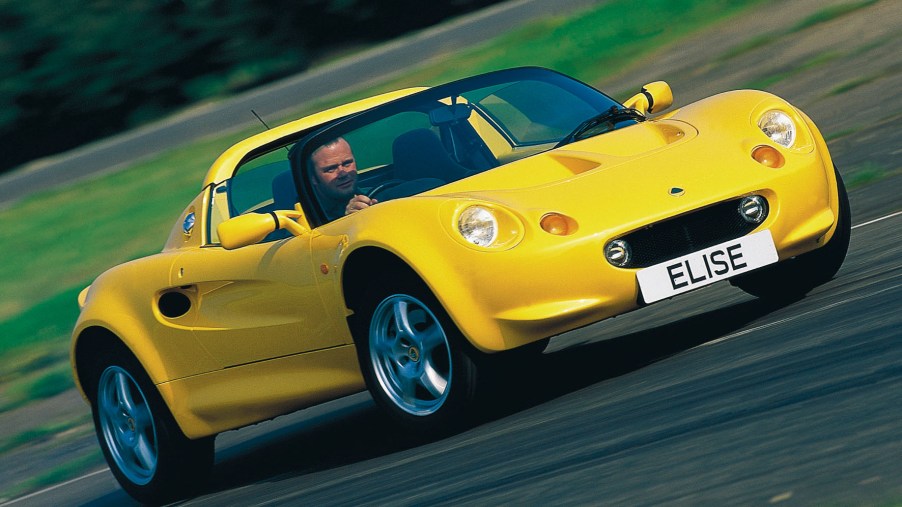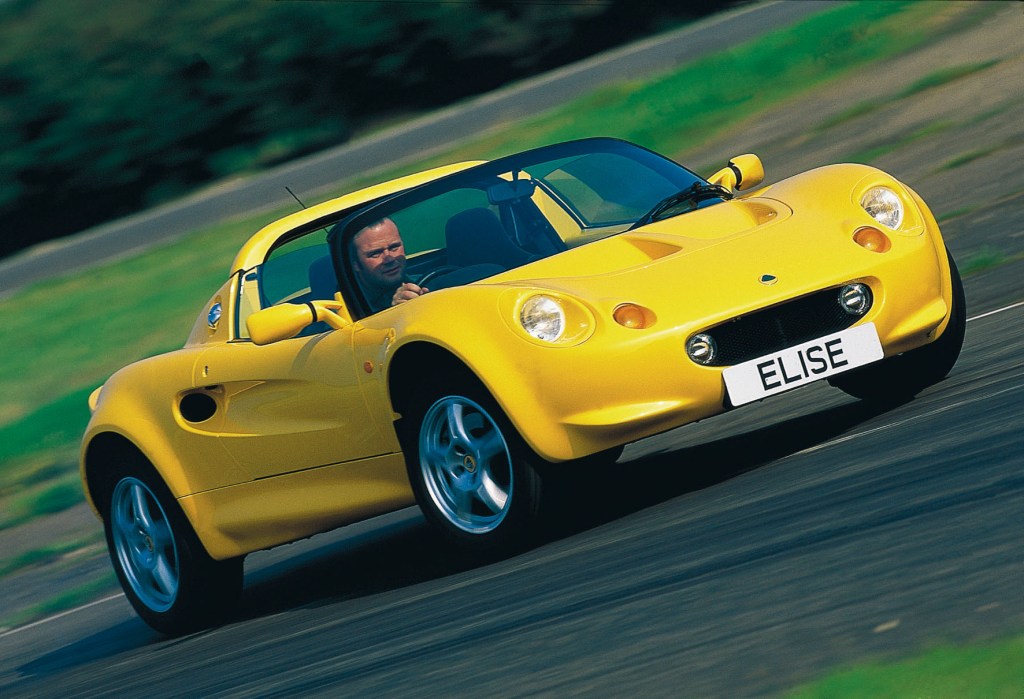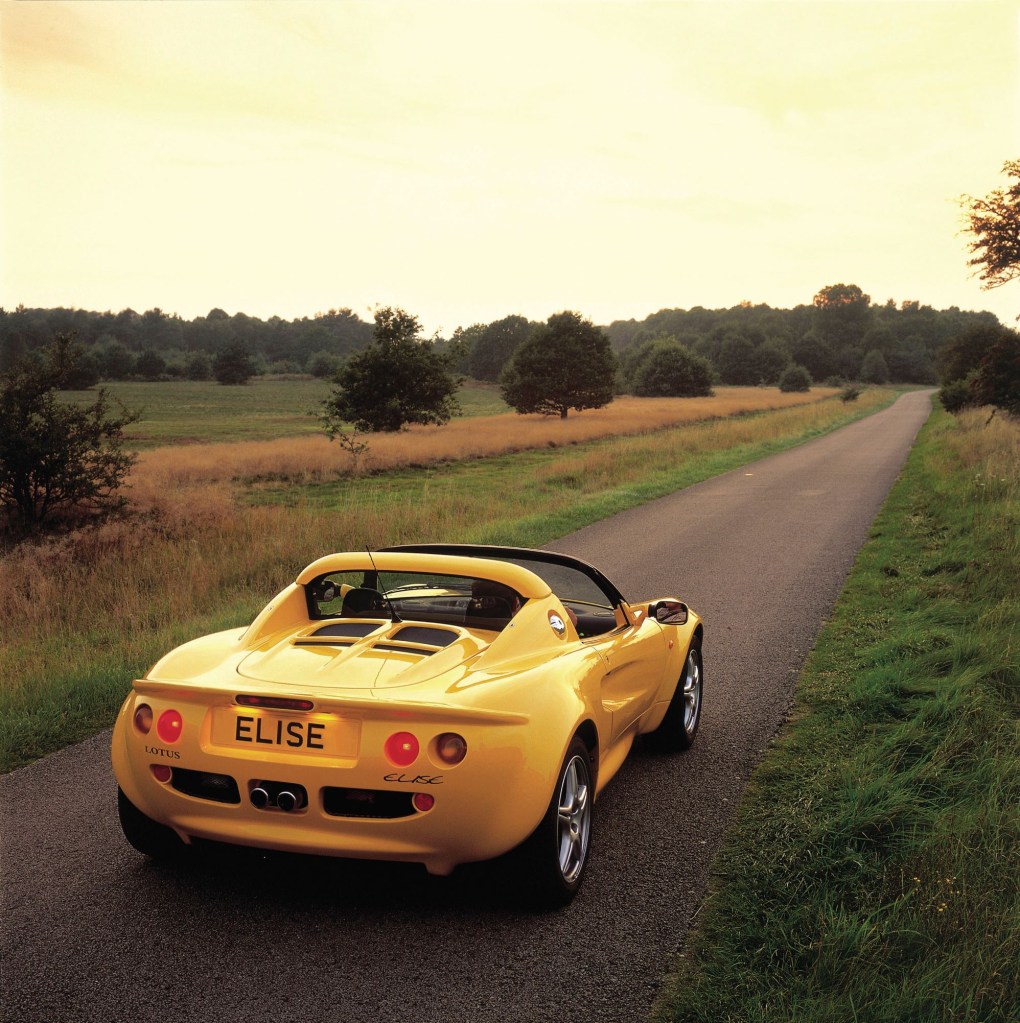
The Light and Simple Lotus Elise S1 Is Finally Import-Eligible
As many JDM fans know, sometimes famed performance nameplates take a while to make it onto US shores. And even after they arrive here, the early models age into classics, leaving American enthusiasts waiting on that 25-year-import mark. In 2021, the wait is over for one beloved British sports car that, initially, couldn’t be sold here: the Lotus Elise S1.
The Lotus Elise S1 is Colin Chapman’s ethos distilled

To be clear, Lotus did sell the Elise in the US for a time. Gabrielle DeSantis, one of the writers here at MotorBiscuit, owns one. However, the first US-market Elise was the S2 (‘Series 2’) model in 2004, The Drive reports. We never got its predecessor, the 1996-2001 Lotus Elise S1. This is a shame because the Elise S1 arguably hews even closer to Lotus founder Colin Chapman’s famed “simplify and add lightness” mantra, Automobile reports.
The S1 Lotus Elise was “a revelation” upon its debut, and in many ways, it still is, Silodrome reports. The British automaker built it out of bonded extruded aluminum using techniques borrowed from double-glazed windows, Hagerty reports. It was a world-first for a production car, Automobile reports, and Lotus would later license the technology to other automakers.

Aluminum is also found in the lightweight silicon-carbide brakes, which were dropped after 1997 due to cost, Evo reports. The body panels, though, are fiberglass. In fact, the only steel parts on a Lotus Elise S1 are the roll bar, part of the rear subframe, and the suspension mounts, Classic & Sports Car reports. And that even extends to the engine bay.
While later Lotus Elise models have Toyota engines, the S1’s engine comes from British automaker rover. The roadster has a mid-mounted 1.8-liter four-cylinder engine rated at 118 hp and 122 lb-ft, sent to the rear wheels via a 5-speed manual, Evo reports. While that’s Miata-level power, the Elise S1 is even lighter. Its construction and relative dearth of crash structures and creature comforts mean it only weighs about 1600 pounds, Autocar reports.
A Lotus Elise S1 is “a feather…made of razorblades [sic] and excitement,” Road & Track says
That lack of weight means the Lotus Elise S1’s relatively modest output is more than enough to have some fun. 0-60 mph takes 5.8 seconds, which is still relatively quick, Road & Track reports. But it has an even greater benefit: nimble handling.
Thanks to the low curb weight and 4-wheel independent suspension, the Lotus Elise S1 is “an absolute gem” to drive, Hagerty reports. The steering is unassisted, but it doesn’t matter, again due to that 1600-lb curb weight. And it lets you feel every inch of the road. Combined with the mid-engine layout, the Elise S1 is a car “you simply point…at a corner and it glides around,” R&T reports. But despite the incredible handling, the ride isn’t overly harsh or stiff. It’s like a Caterham Seven that doesn’t beat you up quite as much over a long drive, Classic & Sports Car reports.
Admittedly, the bare-bones design comes at a price. While Lotus offered leather upholstery and a stereo, the Elise S1 has no A/C, cupholders, or even carpets. It can also be difficult getting in and out of it due to the wide door sills and low ride height. And while it’s not quite as stripped-down as a Caterham, it’s still a fairly raw and noisy car, R&T reports.
Still, if you’re looking for a pure sports car experience, it’s hard to beat a Lotus Elise S1.
Pricing and buyer’s guide
The Lotus Elise S1 was in production until 2001. And during its run, Lotus produced a number of limited-edition variants that offered more power, upgraded brakes and suspension, and in some cases, even less weight. However, for 2021 only the 1996 S1 is eligible for importation.
There are a few things to look out for with early Elise S1s. The head gasket is a known failure point, though stronger replacement parts are available. The fiberglass body panels can be fragile, especially the clamshell hood. And while the aluminum chassis doesn’t rust, the steel rear subframe can. The factory radiator can rust, too, though again, all-aluminum replacements are available. Also, while the Elise S1 has a soft-top roof, it’s not actually fully waterproof; if possible, get one with the optional hard-top.
Originally, the Lotus Elise S1 retailed for about $27k, Top Gear reports, the modern equivalent of $45,000. Today, a good- to excellent-condition example goes for about $17k-$22k, Hagerty reports. In contrast, a US-market Elise hovers in the $30,000-$40,000 range, Bring a Trailer reports. Though keep in mind, if you’re buying an S1 abroad, you’ll have to factor in importation fees.
Follow more updates from MotorBiscuit on our Facebook page.


